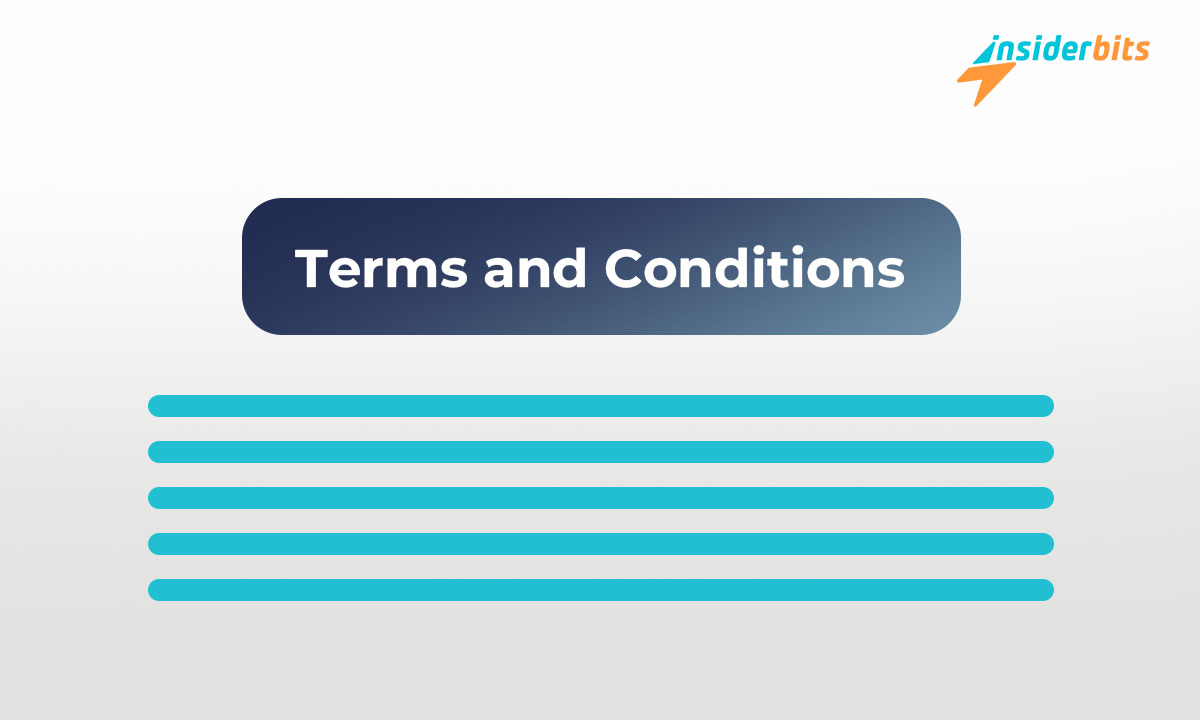Nowadays, where we entrust our personal information to various online platforms, it’s crucial to understand the importance of reading and comprehending Terms and Conditions.
This case study delves into the risks of these agreements and the steps users can take to safeguard their privacy and rights. Insiderbits will highlight how carefully reviewing Terms and Conditions can protect individuals from unexpected fees, loss of intellectual property rights, and potential misuse of their data by companies.
This article aims to educate readers on making informed decisions about the terms they agree to online, emphasizing the significance of informed consent and conscious choices regarding data privacy and security.
What are the Key Components of a Terms and Conditions Document
A comprehensive terms and conditions (T&C) document is a critical legal agreement that establishes the contractual relationship between a business and its users. It should clearly state that the T&C constitutes a binding contract, explain the scope of what it covers, and inform users of potential updates.
The T&C must establish the business’s intellectual property rights, outline acceptable user conduct, and specify grounds for account suspension or termination.
Robust disclaimers, limitations of liability, and governing law and jurisdiction clauses are essential to protect the business’s interests. Pricing, payment terms, refund policies, and a link to the privacy policy should also be included. Drafting thorough, legally sound T&C requires careful consideration of the business’s specific industry and services.
Seeking legal counsel is highly recommended to ensure the document is enforceable and protects both parties.
Careful review of T&C is crucial for users to understand their rights and obligations when engaging with a service or platform.
Understanding Legal Implications of Terms and Conditions
Terms and conditions are critical legal documents that establish the contractual relationship between a business and its users or customers.
Understanding the legal implications of these agreements is essential for both parties to protect their rights and interests.
Here are some key points to consider:
Establishing Binding Contracts
Terms and conditions create a legally binding contract when users agree to them, typically by checking a box or clicking “I agree.” This means the terms are enforceable, and both parties are obligated to adhere to the stated rules and policies.
Defining Intellectual Property Rights
Terms and conditions outline the ownership and usage rights for the content, branding, and intellectual property on a website or platform. This helps prevent unauthorized use or distribution of copyrighted material.
Limiting Business Liability
Carefully crafted terms and conditions can limit a business’s legal liability for issues like data breaches, service disruptions, or user-generated content. Disclaimers and indemnification clauses are common ways to manage risk.
Governing Law and Jurisdiction
Terms and conditions specify the governing law and jurisdiction that will apply in the event of a dispute. This ensures legal issues are resolved according to the appropriate legal framework.
Handling Disputes and Termination
Terms and conditions outline the process for resolving disputes, as well as the grounds and procedures for terminating a user’s access to the service. This provides a clear framework for addressing problems that may arise.
Understanding these legal implications is crucial for businesses to protect themselves and for users to know their rights when engaging with a service or platform. Seeking legal counsel when drafting or reviewing terms and conditions is highly recommended to ensure they are comprehensive and enforceable.
Safeguarding Personal Information by Reading Terms and Conditions
One of the primary reasons it’s crucial to carefully read and understand terms and conditions is to protect your personal information from potential misuse by companies.
Many online services and platforms collect a vast amount of user data, from contact details and browsing history to financial information and location data.
Without thoroughly reviewing the terms, you may unknowingly agree to have this sensitive data shared with third parties or used for purposes you’re uncomfortable with.
By reading the fine print, you can identify clauses that outline how your personal information will be collected, stored, and utilized. This allows you to make an informed decision about whether you’re willing to entrust that data to the company.
Additionally, terms and conditions may specify your rights regarding data deletion, opt-out options, and the ability to access the information the company has on file.
Ultimately, taking the time to carefully review terms and conditions is a proactive step towards safeguarding your personal information and avoiding potential misuse by companies that may not have your best interests in mind.
The Importance of Informed Consent and Conscious Data Privacy Decisions
Understanding terms and conditions lies in the significance of informed consent and making conscious decisions about data privacy and security.
When users blindly agree to lengthy legal documents without fully comprehending the implications, they risk unwittingly surrendering control over their personal information and digital footprint.
By carefully reviewing terms and conditions, users can gain a clear understanding of how their data will be collected, used, and potentially shared. This empowers them to make informed choices about the level of access and permissions they are comfortable granting to a service or platform.
Informed consent also ensures that users are aware of their rights, such as the ability to access, modify, or delete their data.
This level of transparency and control is essential for building trust between individuals and the companies they entrust with their sensitive information. Ultimately, making conscious decisions about data privacy and security is a fundamental aspect of digital literacy and personal empowerment in the modern age.
Why You Should Always Read Terms & Conditions – Conclusion
Carefully reading and comprehending the terms and conditions of online services and platforms is crucial for safeguarding personal information and making informed decisions about data privacy.
Reviewing terms and conditions empowers individuals to make conscious choices about the information they share and the level of access they grant to companies. As our digital lives become increasingly intertwined, taking the time to read the fine print is an essential step toward maintaining control over our personal data and online experiences.
Staying vigilant about terms and conditions is a fundamental aspect of digital literacy in the modern age.
En rapport : Comment créer sa propre page Wikipédia ?
Cet article vous plaît ? Ajoutez le blog Insiderbits à vos favoris et visitez-nous chaque fois que vous voulez apprendre de nouvelles informations passionnantes sur la technologie et bien plus encore !





